Spring03-AOP(动态代理模式,环绕通知,增强方法)、事务
文章目录
- 今日目标
- 一、AOP
- 1 AOP简介
- 问题导入
- 1.1 AOP简介和作用【理解】
- 1.2 AOP中的核心概念【理解】
- 2 AOP入门案例【重点】
- 问题导入
- 2.1 AOP入门案例思路分析
- 2.2 AOP入门案例实现
- 【第一步】导入aop相关坐标
- 【第二步】定义dao接口与实现类 (以及核心配置类)
- 【第三步】定义通知类,制作通知方法
- 【第四步】定义切入点表达式、配置切面(绑定切入点与通知关系)
- 【第五步】在配置类中进行Spring注解包扫描和开启AOP功能
- 测试类和运行结果
- 3 AOP工作流程【理解】
- 问题导入
- 3.1 AOP工作流程
- 3.2 AOP核心概念
- 3.3 在测试类中验证代理对象
- 4 AOP切入点表达式
- 问题导入
- 4.1 语法格式
- 4.2 通配符
- 4.3 书写技巧
- 5 AOP通知类型【重点】
- 问题导入
- 5.1 AOP通知分类
- 5.2 AOP通知详解
- 5.2.1 前置通知
- 5.2.2 后置通知
- 5.2.3 返回后通知
- 5.2.4 抛出异常后通知
- 5.2.5 环绕通知 (★)
- 二、AOP案例
- 1 案例-测量业务层接口万次执行效率
- 问题导入
- 1.1 需求和分析
- 1.2 代码实现
- 【前置工作】环境准备
- 【第一步】编写通知类
- 【第二步】在SpringConfig配置类上开启AOP注解功能
- 【第三步】运行测试类,查看结果
- //TODO
- 2 AOP切入点数据获取
- 问题导入
- 2.1 获取参数
- 2.2 获取返回值
- 2.3 获取异常
- 3 案例-百度网盘密码数据兼容处理
- 问题导入
- 3.1 需求和分析
- 3.2 代码实现
- 【前置工作】环境准备
- 【第一步】编写通知类
- 【第二步】在SpringConfig配置类上开启AOP注解功能
- 【第三步】运行测试类,查看结果
- 4 AOP开发总结
- 4.1 AOP的核心概念
- 4.2 切入点表达式语法
- 4.3 五种通知类型
今日目标
- 能够理解AOP的作用
- 能够完成AOP的入门案例
- 能够理解AOP的工作流程
- 能够说出AOP的五种通知类型
- 能够完成"测量业务层接口万次执行效率"案例
- 能够掌握Spring事务配置
一、AOP
1 AOP简介
问题导入
问题1:AOP的作用是什么?
问题2:连接点和切入点有什么区别,二者谁的范围大?
问题3:请描述什么是切面?
1.1 AOP简介和作用【理解】
- AOP(Aspect Oriented Programming)面向切面编程,一种编程范式,指导开发者如何组织程序结构
- OOP(Object Oriented Programming)面向对象编程
- 作用:在不惊动原始设计的基础上为其进行功能增强。简单的说就是在不改变方法源代码的基础上对方法进行功能增强。
- Spring理念:无入侵式/无侵入式
1.2 AOP中的核心概念【理解】
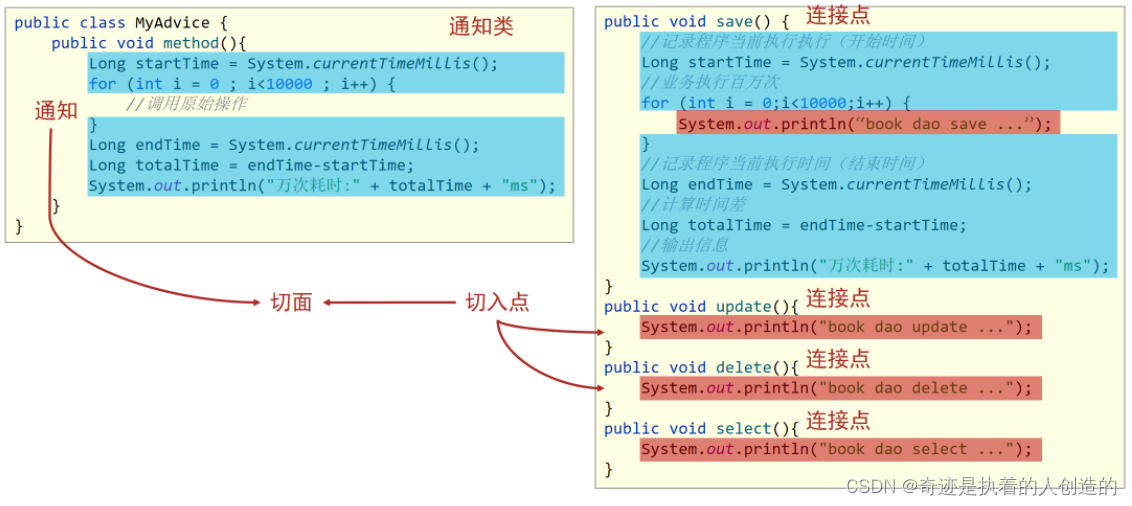
- 连接点(JoinPoint):正在执行的方法,例如:update()、delete()、select()等都是连接点。
- 切入点(Pointcut):进行功能增强了的方法,例如:update()、delete()方法,select()方法没有被增强所以不是切入点,但是是连接点。
- 在SpringAOP中,一个切入点可以只描述一个具体方法,也可以匹配多个方法
- 一个具体方法:cn.whu.dao包下的BookDao接口中的无形参无返回值的save方法
- 匹配多个方法:所有的save方法,所有的get开头的方法,所有以Dao结尾的接口中的任意方法,所有带有一个参数的方法
- 在SpringAOP中,一个切入点可以只描述一个具体方法,也可以匹配多个方法
- 通知(Advice):在切入点前后执行的操作,也就是增强的共性功能
- 在SpringAOP中,功能最终以方法的形式呈现
- 通知类:通知方法所在的类叫做通知类
- 切面(Aspect):描述通知与切入点的对应关系,也就是哪些通知方法对应哪些切入点方法。
2 AOP入门案例【重点】
问题导入
问题1:在通知方法中如何定义切入点表达式?
问题2:如何配置切面?
问题3:在配置类上如何开启AOP注解功能?
2.1 AOP入门案例思路分析
- 案例设定:测定接口执行效率
- 简化设定:在接口执行前输出当前系统时间
- 开发模式:XML or 注解
- 思路分析:
- 导入坐标(pom.xml)
- 制作连接点方法(原始操作,dao接口与实现类)
- 制作共性功能(通知类与通知)
- 定义切入点
- 绑定切入点与通知关系(切面)
2.2 AOP入门案例实现
初始环境搭建:
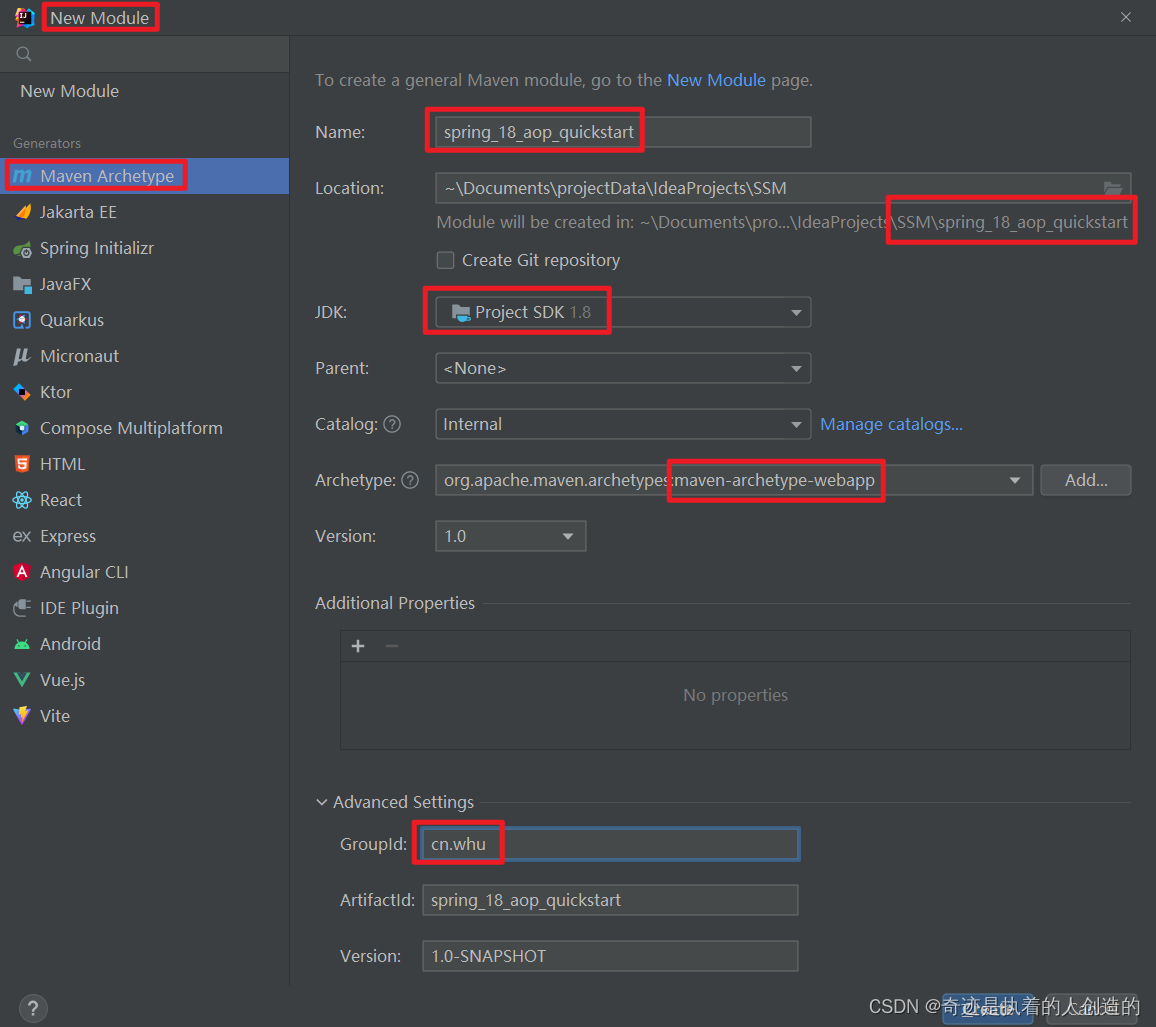
创建目录和类:
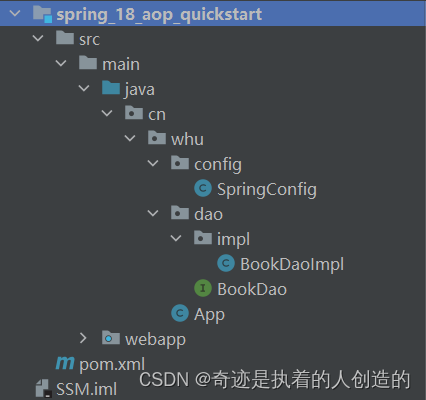
导入下面第一步的坐标
pom.xml
4.0.0 cn.whu spring_18_aop_quickstart war 1.0-SNAPSHOT org.springframework spring-context 5.2.10.RELEASE org.aspectj aspectjweaver 1.9.4 基础代码:
@Configuration
@ComponentScan("cn.whu")
public class SpringConfig {
}public interface BookDao {public void save();public void update();
}@Repository
public class BookDaoImpl implements BookDao {public void save() {System.out.println(LocalDateTime.now());System.out.println("book dao save");}public void update() {System.out.println("book dao update ...");}
}//!!!导入一个包 三个注解 Spring就用起来了 !!!
public class App {public static void main(String[] args) {ApplicationContext ioc = new AnnotationConfigApplicationContext(SpringConfig.class);BookDao bookDao = ioc.getBean(BookDao.class);bookDao.save();System.out.println("--------------");bookDao.update();}
}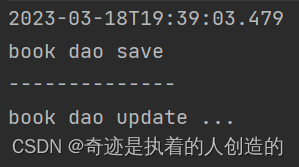
下面再从AOP角度梳理步骤:前两步环境里已经有了 不需要再做了
【第一步】导入aop相关坐标
org.springframework spring-context 5.2.10.RELEASE org.aspectj aspectjweaver 1.9.4 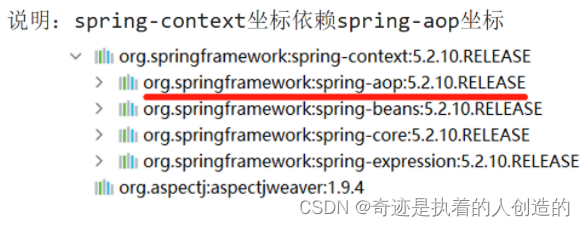
【第二步】定义dao接口与实现类 (以及核心配置类)
public interface BookDao {public void save();public void update();
}@Repository
public class BookDaoImpl implements BookDao {public void save() {System.out.println(LocalDateTime.now());System.out.println("book dao save ...");}public void update(){System.out.println("book dao update ...");}
}@Configuration
@ComponentScan("cn.whu")
public class SpringConfig {
}
【第三步】定义通知类,制作通知方法
//通知类必须配置成Spring管理的bean
@Component //肯定给SpringIoC管理呀
public class MyAdvice {public void method(){System.out.println(System.currentTimeMillis());}
}
【第四步】定义切入点表达式、配置切面(绑定切入点与通知关系)
切入点定义依托一个不具有实际意义的方法进行,即无参数,无返回值,方法体无实际逻辑
@Component //给SpringIoC当做Bean管理 [专业术语: 通知类必须配置成Spring管理的bean]
@Aspect //告诉Spring这是做AOP的 [专业术语: 设置当前类为通知类]
public class MyAdvice {//设置切入点: 也就是定义在谁那里执行//@Pointcut注解要求配置在方法上方@Pointcut("execution(void cn.whu.dao.BookDao.update())")//切入点定义在哪执行private void pt(){}//设置在切入点pt()的前面运行当前操作(前置通知)@Before("pt()")//共性功能(通知)和在哪执行(切入点)绑定起来//定义共性功能public void method(){//方法名任意System.out.println(LocalDateTime.now());}
}

【第五步】在配置类中进行Spring注解包扫描和开启AOP功能
@Configuration
@ComponentScan("cn.whu")
//开启注解开发AOP功能 (因为不确定是xml还是注解方式 所以要注明下)
@EnableAspectJAutoProxy
public class SpringConfig {
}
测试类和运行结果
public class App {public static void main(String[] args) {ApplicationContext ctx = new AnnotationConfigApplicationContext(SpringConfig.class);BookDao bookDao = ctx.getBean(BookDao.class);bookDao.update();}
}
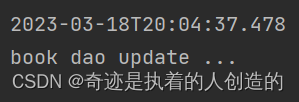
update方法里没有打印时间的代码,是通知方法中的打印时间放执行了,说明对原始方法进行了增强,AOP编程成功
(也就多写了一个类和5个注解)
3 AOP工作流程【理解】
问题导入
什么是目标对象?什么是代理对象?
3.1 AOP工作流程
- Spring容器启动
- 读取所有切面配置中的切入点 (@Pointcut定义了但没有@Before(“pt()”)配置的切入点不读取)
- 初始化bean,判定bean对应的类中的方法是否匹配到任意切入点
- 匹配失败,创建原始对象
- 匹配成功,创建原始对象(目标对象)的代理对象
- 获取bean执行方法
- 获取的bean是原始对象时,调用方法并执行,完成操作
- 获取的bean是代理对象时,根据代理对象的运行模式运行原始方法与增强的内容,完成操作
3.2 AOP核心概念
目标对象(Target):被代理的对象,也叫原始对象,该对象中的方法没有任何功能增强。
代理对象(Proxy):代理后生成的对象,由Spring帮我们创建代理对象。
3.3 在测试类中验证代理对象
public class App {public static void main(String[] args) {ApplicationContext ctx = new AnnotationConfigApplicationContext(SpringConfig.class);BookDao bookDao = ctx.getBean(BookDao.class);bookDao.update();//打印对象的类名System.out.println(bookDao.getClass());}
}

参考:https://blog.csdn.net/m0_52012606/article/details/122585571
静态代理,实现该类的顶层接口,导入该类对象为属性,重新实现对应的接口方法,在调用方法执行执行前后添加一些操作,就实现了对方法的增强,但是这增强一个方法就得写一个类实现"重写"一次,太麻烦了吧。
景泰代理:传入类全路径.方法,通过反射增强,就简单方便多了
4 AOP切入点表达式
问题导入
在切入点表达式中如何简化包名和参数类型书写?
4.1 语法格式
-
切入点:要进行增强的方法
-
切入点表达式:要进行增强的方法的描述方式
- 描述方式一:执行com.itheima.dao包下的BookDao接口中的无参数update方法
execution(void com.itheima.dao.BookDao.update())- 描述方式二:执行com.itheima.dao.impl包下的BookDaoImpl类中的无参数update方法
execution(void com.itheima.dao.impl.BookDaoImpl.update())也就是说切入点描述的是实现类或者接口都ok
-
切入点表达式标准格式:动作关键字(访问修饰符 返回值 包名.类/接口名.方法名(参数) 异常名)
execution(public User com.itheima.service.UserService.findById(int))- 动作关键字:描述切入点的行为动作,例如execution表示执行到指定切入点
- 访问修饰符:public,private等,可以省略
- 返回值:写返回值类型
- 包名:多级包使用点连接
- 类/接口名:
- 方法名:
- 参数:直接写参数的类型,多个类型用逗号隔开
- 异常名:方法定义中抛出指定异常,可以省略
一个一个写也累 所以肯定有通配符匹配的写法
4.2 通配符
目的:可以使用通配符描述切入点,快速描述。
- :单个独立的任意符号,可以独立出现,也可以作为前缀或者后缀的匹配符出现
匹配com.itheima包下的任意包中的UserService类或接口中所有find开头的带有(任意类型)一个参数的方法
execution(public * com.itheima.*.UserService.find*(*))
- … :多个连续的任意符号,可以独立出现,常用于简化包名与参数的书写
匹配com包下的任意包中的UserService类或接口中所有名称为findById的方法
execution(public User com..UserService.findById(..))
- +:专用于匹配子类类型
execution(* *..*Service+.*(..))
*表示1个
..表示任意
…
从后往前看,()内肯定是参数,倒数第一个肯定是方法名,倒数第二个肯定类或接口名,再往回倒就不确定了
execution(* *..*.*(..))任意包下任意方法 可太疯狂了 可不能这么配
execution(* *..u*(..))任意u开头的方法
execution(* *..*e(..))任意e结尾的方法
execution(* *…Service+.(…)) 所有Service类或者接口的子类
execution(* cn.whu.*.*Service.find*(..))所有业务层查询方法加AOP
4.3 书写技巧
- 所有代码按照标准规范开发,否则以下技巧全部失效
- 描述切入点通常描述接口,而不描述实现类 (为了解耦)
- 访问控制修饰符针对接口开发均采用public描述(可省略访问控制修饰符描述)
- 返回值类型对于增删改类使用精准类型加速匹配,对于查询类使用*通配快速描述
- 包名书写尽量不使用…匹配,效率过低,常用*做单个包描述匹配,或精准匹配
- 接口名/类名书写名称与模块相关的采用*匹配,例如UserService书写成*Service,绑定业务层接口名
- 方法名书写以动词进行精准匹配,名词采用匹配,例如getById书写成getBy,selectAll书写成selectAll
- 参数规则较为复杂,根据业务方法灵活调整
- 通常 不使用异常作为匹配规则
5 AOP通知类型【重点】
问题导入
请描述一下如何定义环绕通知方法?
5.1 AOP通知分类
- AOP通知描述了抽取的共性功能,根据共性功能抽取的位置不同,最终运行代码时要将其加入到合理的位置
- AOP通知共分为5种类型
- 前置通知:在切入点方法执行之前执行
- 后置通知:在切入点方法执行之后执行,无论切入点方法内部是否出现异常,后置通知都会执行。
- 环绕通知(重点):手动调用切入点方法并对其进行增强的通知方式。
- 返回后通知(了解):在切入点方法执行之后执行,如果切入点方法内部出现异常将不会执行。
- 抛出异常后通知(了解):在切入点方法执行之后执行,只有当切入点方法内部出现异常之后才执行。
5.2 AOP通知详解
环境准备,复制一份上面的module,修改如下:
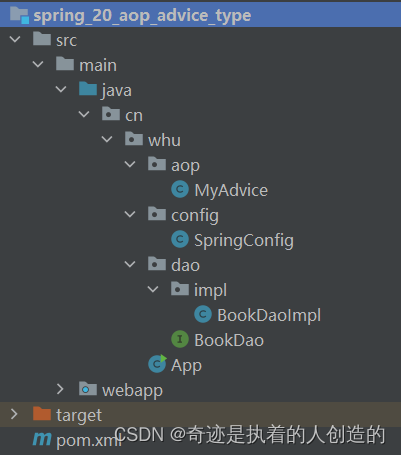
public interface BookDao {public void update();public int select();
}
@Repository
public class BookDaoImpl implements BookDao {@Overridepublic void update() {System.out.println("book dao update is running ...");}@Overridepublic int select() {System.out.println("book dao select is running ...");return 100;}
}@Configuration
@ComponentScan("cn.whu")
@EnableAspectJAutoProxy
public class SpringConfig {}public class App {public static void main(String[] args) {ApplicationContext ioc = new AnnotationConfigApplicationContext(SpringConfig.class);BookDao bookDao = ioc.getBean(BookDao.class);bookDao.update();}
}
@Component
@Aspect
public class MyAdvice {@Pointcut("execution(void cn.whu.dao.BookDao.update())")private void pt(){}public void before(){System.out.println("before advice ...");}public void after(){System.out.println("after advice ...");}public void around(){System.out.println("around before advice ...");System.out.println("around after advice ...");}public void afterReturning(){System.out.println("afterReturning advice ...");}public void afterThrowing(){System.out.println("afterThrowing advice ...");}
}
5.2.1 前置通知
- 名称:@Before
- 类型:方法注解
- 位置:通知方法定义上方
- 作用:设置当前通知方法与切入点之间的绑定关系,当前通知方法在原始切入点方法前运行
- 范例:
@Before("pt()")
public void before() {System.out.println("before advice ...");
}
调用上面的测试方法执行update方法,会在方法体执行前执行before()进行打印
5.2.2 后置通知
- 名称:@After
- 类型:方法注解
- 位置:通知方法定义上方
- 作用:设置当前通知方法与切入点之间的绑定关系,当前通知方法在原始切入点方法后运行(抛异常了也会执行)
- 范例:
@After("pt()")
public void after() {System.out.println("after advice ...");
}
调用上面的测试方法执行update方法,会在方法体执行后执行after()进行打印
5.2.3 返回后通知
- 名称:@AfterReturning(了解)
- 类型:方法注解
- 位置:通知方法定义上方
- 作用:设置当前通知方法与切入点之间的绑定关系,当前通知方法在原始切入点方法正常执行完毕后运行(抛异常了就不会执行)
- 范例:
@AfterReturning("pt()")
public void afterReturning() {System.out.println("afterReturning advice ...");
}
5.2.4 抛出异常后通知
- 名称:@AfterThrowing(了解)
- 类型:方法注解
- 位置:通知方法定义上方
- 作用:设置当前通知方法与切入点之间的绑定关系,当前通知方法在原始切入点方法运行抛出异常后执行
- 范例:
@AfterThrowing("pt()")
public void afterThrowing() {System.out.println("afterThrowing advice ...");
}
5.2.5 环绕通知 (★)
- 名称:@Around(重点,常用)
- 类型:方法注解
- 位置:通知方法定义上方
- 作用:设置当前通知方法与切入点之间的绑定关系,当前通知方法在原始切入点方法前后运行
- 范例::
@Around("pt()")
public Object around(ProceedingJoinPoint pjp) throws Throwable {System.out.println("around before advice ...");Object ret = pjp.proceed();//环绕通知有返回值 必须接收下来并原路返回System.out.println("around after advice ...");return ret;
}
调用上面的测试方法执行update方法,会在方法体执行前执行
"around before advice ..."打印,执行后执行System.out.println("around after advice ...");打印
环绕通知注意事项
- 环绕通知方法形参必须是ProceedingJoinPoint,表示正在执行的连接点,使用该对象的proceed()方法表示对原始对象方法进行调用,返回值为原始对象方法的返回值。
- 环绕通知方法的返回值建议写成Object类型,用于将原始对象方法的返回值进行返回,哪里使用代理对象就返回到哪里。
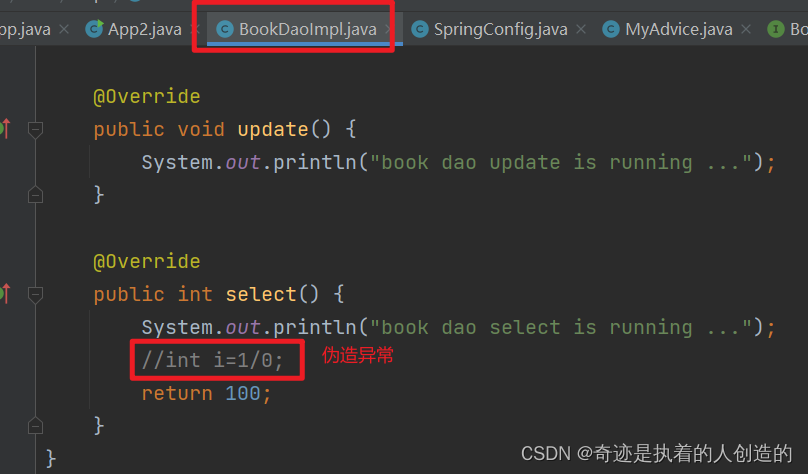
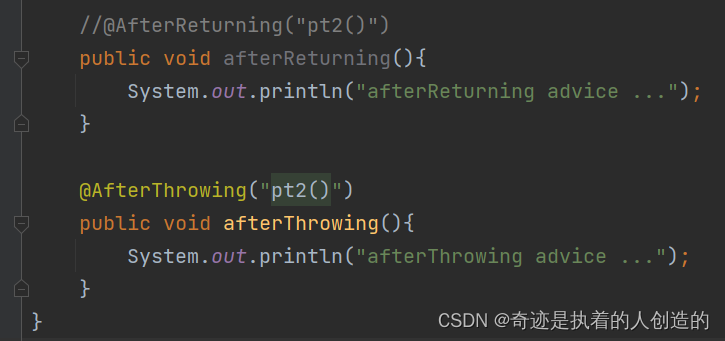

最终aop.MyAdvice.java
@Component
@Aspect
public class MyAdvice {@Pointcut("execution(void cn.whu.dao.BookDao.update())")private void pt(){}@Pointcut("execution(int cn.whu.dao.BookDao.select())")private void pt2(){}//@Before("pt()")public void before(){System.out.println("before advice ...");}//After("pt2()")public void after(){System.out.println("after advice ...");}//@Around("pt()") //最重要最常用public void around(ProceedingJoinPoint pjp) throws Throwable {System.out.println("around before advice ...");//环绕肯定要手动对原始操作进行调用,格式也是固定的pjp.proceed();System.out.println("around after advice ...");}//@Around("pt2()")//原来函数有返回值 环绕通知这里得返回Object类型,接收调用得返回值并返回public Object aroundSelect(ProceedingJoinPoint pjp) throws Throwable {System.out.println("around before advice ...");//环绕肯定要手动对原始操作进行调用,格式也是固定的Object ret = pjp.proceed();System.out.println("around after advice ...");return ret;}//@AfterReturning("pt2()")public void afterReturning(){System.out.println("afterReturning advice ...");}@AfterThrowing("pt2()")public void afterThrowing(){System.out.println("afterThrowing advice ...");}
}
二、AOP案例
1 案例-测量业务层接口万次执行效率
问题导入
能不能描述一下环绕通知里面的实现步骤?
1.1 需求和分析
需求:任意业务层接口执行均可显示其执行效率(执行时长)
分析:
①:业务功能:业务层接口执行前后分别记录时间,求差值得到执行效率
②:通知类型选择前后均可以增强的类型——环绕通知
1.2 代码实现
【前置工作】环境准备
-
Spring整合mybatis对spring_db数据库中的Account进行CRUD操作
-
Spring整合Junit测试CRUD是否OK。
-
在pom.xml中添加aspectjweaver切入点表达式依赖
-
… …
环境准备:就是前面spring整合junit(mybatis也整合了)的module(spring_16_spring_junit)复制一份,就是本案例的初始环境
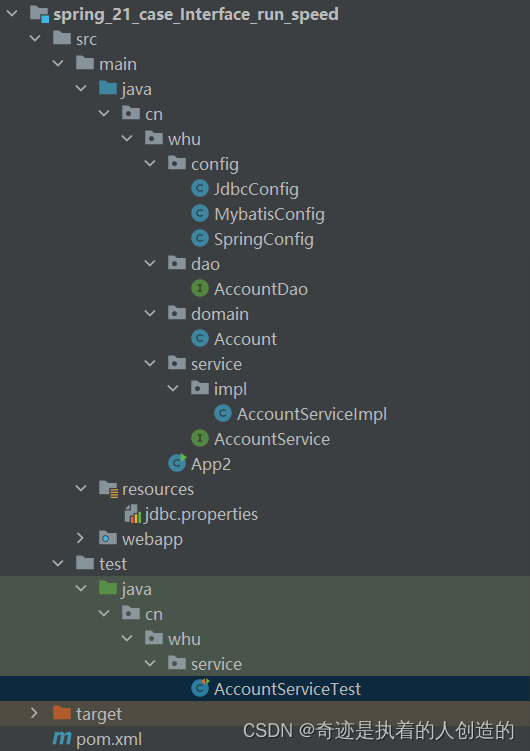
注意加入aspectj依赖
org.aspectj aspectjweaver 1.9.4
【第一步】编写通知类
@Component
@Aspect
public class ProjectAdvice {@Pointcut("execution(* cn.whu.service.*Service.*(..))")//service层的所有方法 (最后的.*方法名匹配别忘了)private void servicePt(){}//切入点方法 private权限//@Around("servicePt()") //环绕通知 别写错了@Around("ProjectAdvice.servicePt()") //这么写也行 "类名.方法名" 这么写可以引入别的类里面定义的切入点public Object runSpeed(ProceedingJoinPoint pjp) throws Throwable {Signature signature = pjp.getSignature(); //获取执行的签名对象//cn.whu.service.AccountServiceString className = signature.getDeclaringTypeName().toString(); //获取接口/类全限定名//findByIdString methodName = signature.getName(); //获取方法名//cn.whu.service.AccountService.findByIdString classMethodName = className+"."+methodName; //完整名称//System.out.println(classMethodName);//执行万次 并统计时间long start = System.currentTimeMillis();Object ret=null;for(int i=0;i<10000;i++){ret = pjp.proceed();}long end = System.currentTimeMillis();System.out.println(classMethodName +" 的万次运行时间: "+(end-start)+" ms");return ret;}
}
【第二步】在SpringConfig配置类上开启AOP注解功能
@Configuration
@ComponentScan("com.itheima")
@PropertySource("classpath:jdbc.properties")
@Import({JdbcConfig.class,MybatisConfig.class})
@EnableAspectJAutoProxy //开启AOP注解功能
public class SpringConfig {
}
【第三步】运行测试类,查看结果
@RunWith(SpringJUnit4ClassRunner.class)
@ContextConfiguration(classes = SpringConfig.class)
public class AccountServiceTestCase {@Autowiredprivate AccountService accountService;@Testpublic void testFindById(){Account account = accountService.findById(1);}@Testpublic void testFindAll(){List list = accountService.findAll();}
}


findAll快点,findById慢点,因为findById还要在findAll的基础上进行一次筛选
//TODO
2 AOP切入点数据获取
问题导入
在环绕通知中可以获取到哪些数据?
2.1 获取参数
说明:在前置通知和环绕通知中都可以获取到连接点方法的参数们
- JoinPoint对象描述了连接点方法的运行状态,可以获取到原始方法的调用参数
@Before("pt()")
public void before(JoinPoint jp) {Object[] args = jp.getArgs(); //获取连接点方法的参数们System.out.println(Arrays.toString(args));
}
- ProccedJointPoint是JoinPoint的子类
@Around("pt()")
public Object around(ProceedingJoinPoint pjp) throws Throwable {Object[] args = pjp.getArgs(); //获取连接点方法的参数们System.out.println(Arrays.toString(args));Object ret = pjp.proceed();return ret;
}
2.2 获取返回值
说明:在返回后通知和环绕通知中都可以获取到连接点方法的返回值
- 抛出异常后通知可以获取切入点方法中出现的异常信息,使用形参可以接收对应的异常对象
@AfterReturning(value = "pt()",returning = "ret")
public void afterReturning(String ret) { //变量名要和returning="ret"的属性值一致System.out.println("afterReturning advice ..."+ret);
}
- 环绕通知中可以手工书写对原始方法的调用,得到的结果即为原始方法的返回值
@Around("pt()")
public Object around(ProceedingJoinPoint pjp) throws Throwable {// 手动调用连接点方法,返回值就是连接点方法的返回值Object ret = pjp.proceed();return ret;
}
2.3 获取异常
说明:在抛出异常后通知和环绕通知中都可以获取到连接点方法中出现的异常
- 抛出异常后通知可以获取切入点方法中出现的异常信息,使用形参可以接收对应的异常对象
@AfterThrowing(value = "pt()",throwing = "t")
public void afterThrowing(Throwable t) {//变量名要和throwing = "t"的属性值一致System.out.println("afterThrowing advice ..."+ t);
}
- 抛出异常后通知可以获取切入点方法运行的异常信息,使用形参可以接收运行时抛出的异常对象
@Around("pt()")
public Object around(ProceedingJoinPoint pjp) {Object ret = null;//此处需要try...catch处理,catch中捕获到的异常就是连接点方法中抛出的异常try {ret = pjp.proceed();} catch (Throwable t) {t.printStackTrace();}return ret;
}
3 案例-百度网盘密码数据兼容处理
问题导入
请说出我们该使用什么类型的通知来完成这个需求?
3.1 需求和分析
需求:对百度网盘分享链接输入密码时尾部多输入的空格做兼容处理
[外链图片转存失败,源站可能有防盗链机制,建议将图片保存下来直接上传(img-6iiXd4j9-1679148305925)(assets/image-20210731193059709.png)]
分析:
①:在业务方法执行之前对所有的输入参数进行格式处理——trim()
②:使用处理后的参数调用原始方法——环绕通知中存在对原始方法的调用
3.2 代码实现
【前置工作】环境准备
//-------------service层代码-----------------------
public interface ResourcesService {public boolean openURL(String url ,String password);
}
@Service
public class ResourcesServiceImpl implements ResourcesService {@Autowiredprivate ResourcesDao resourcesDao;public boolean openURL(String url, String password) {return resourcesDao.readResources(url,password);}
}
//-------------dao层代码-----------------------
public interface ResourcesDao {boolean readResources(String url, String password);
}
@Repository
public class ResourcesDaoImpl implements ResourcesDao {public boolean readResources(String url, String password) {System.out.println(password.length());//模拟校验return password.equals("root");}
}
【第一步】编写通知类
@Component
@Aspect
public class DataAdvice {@Pointcut("execution(boolean com.itheima.service.*Service.*(*,*))")private void servicePt(){}@Around("DataAdvice.servicePt()")public Object trimStr(ProceedingJoinPoint pjp) throws Throwable {Object[] args = pjp.getArgs();for (int i = 0; i < args.length; i++) {//判断参数是不是字符串if(args[i].getClass().equals(String.class)){args[i] = args[i].toString().trim();}}Object ret = pjp.proceed(args);return ret;}
}
【第二步】在SpringConfig配置类上开启AOP注解功能
@Configuration
@ComponentScan("com.itheima")
@EnableAspectJAutoProxy
public class SpringConfig {
}
【第三步】运行测试类,查看结果
public class App {public static void main(String[] args) {ApplicationContext ctx = new AnnotationConfigApplicationContext(SpringConfig.class);ResourcesService resourcesService = ctx.getBean(ResourcesService.class);boolean flag = resourcesService.openURL("http://pan.baidu.com/haha", "root ");System.out.println(flag);}
}
4 AOP开发总结
4.1 AOP的核心概念
- 概念:AOP(Aspect Oriented Programming)面向切面编程,一种编程范式
- 作用:在不惊动原始设计的基础上为方法进行功能增强
- 核心概念
- 代理(Proxy):SpringAOP的核心本质是采用代理模式实现的
- 连接点(JoinPoint): 在SpringAOP中,理解为任意方法的执行
- 切入点(Pointcut):匹配连接点的式子,也是具有共性功能的方法描述
- 通知(Advice):若干个方法的共性功能,在切入点处执行,最终体现为一个方法
- 切面(Aspect):描述通知与切入点的对应关系
- 目标对象(Target):被代理的原始对象成为目标对象
4.2 切入点表达式语法
-
切入点表达式标准格式:动作关键字(访问修饰符 返回值 包名.类/接口名.方法名(参数)异常名)
- execution(* com.itheima.service.Service.(…))
-
切入点表达式描述通配符:
- 作用:用于快速描述,范围描述
- *:匹配任意符号(常用)
- … :匹配多个连续的任意符号(常用)
- +:匹配子类类型
-
切入点表达式书写技巧
1.按标准规范开发
2.查询操作的返回值建议使用*匹配
3.减少使用…的形式描述包
4.对接口进行描述,使用*表示模块名,例如UserService的匹配描述为*Service
5.方法名书写保留动词,例如get,使用*表示名词,例如getById匹配描述为getBy*
6.参数根据实际情况灵活调整
4.3 五种通知类型
- 前置通知
- 后置通知
- 环绕通知(重点)
- 环绕通知依赖形参ProceedingJoinPoint才能实现对原始方法的调用
- 环绕通知可以隔离原始方法的调用执行
- 环绕通知返回值设置为Object类型
- 环绕通知中可以对原始方法调用过程中出现的异常进行处理
- 返回后通知
- 抛出异常后通知
